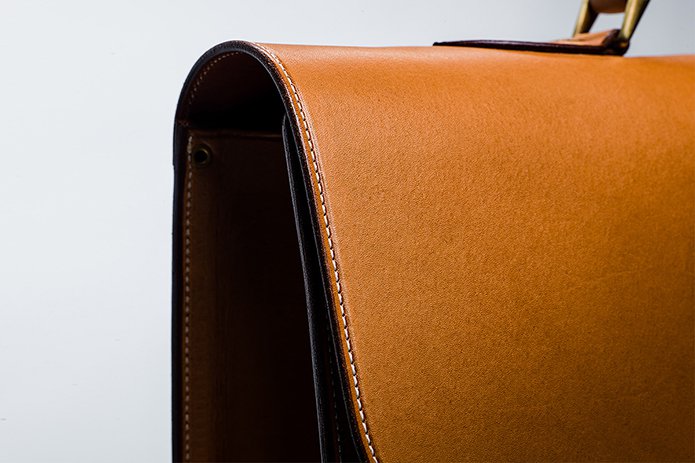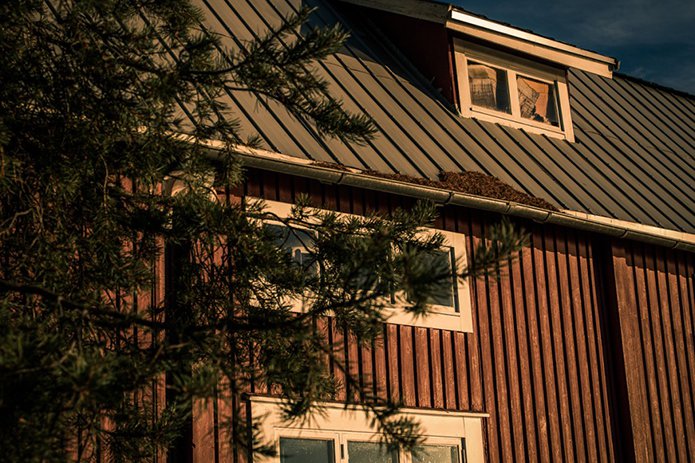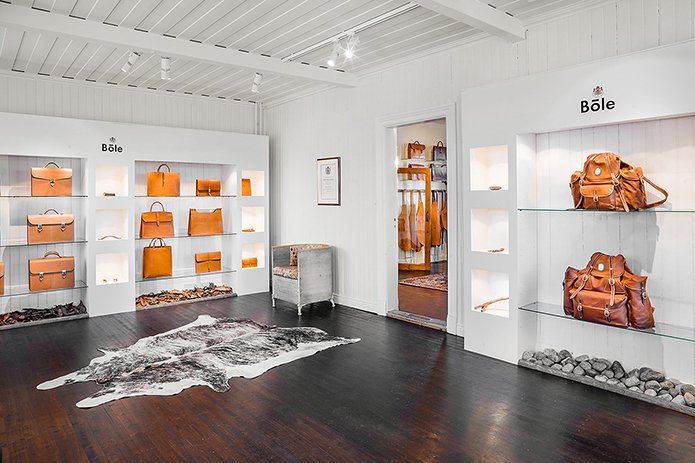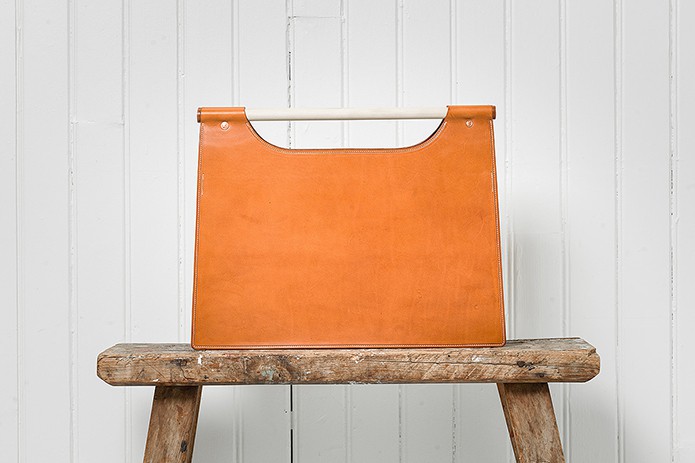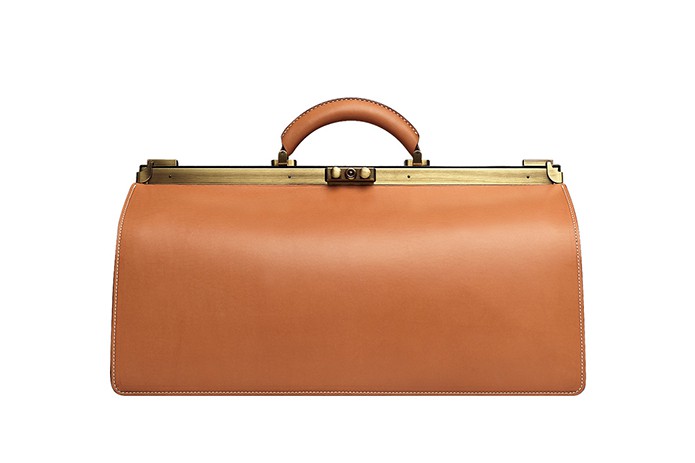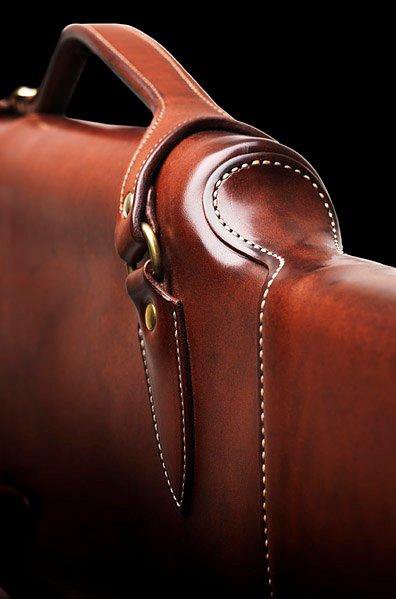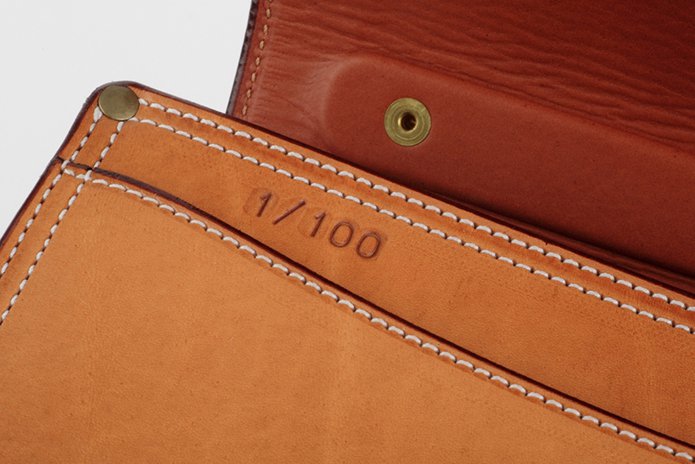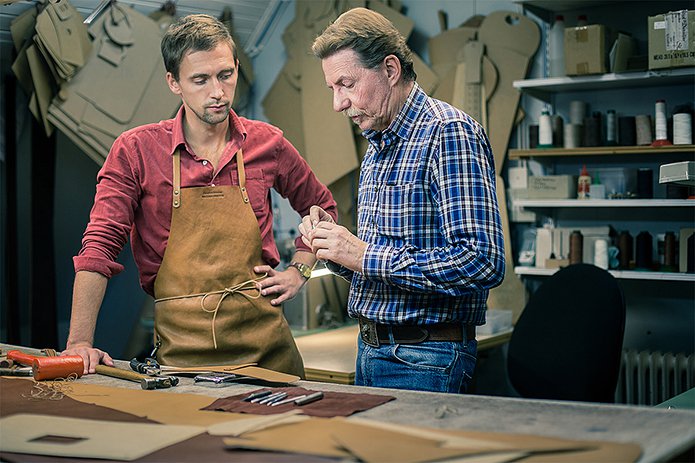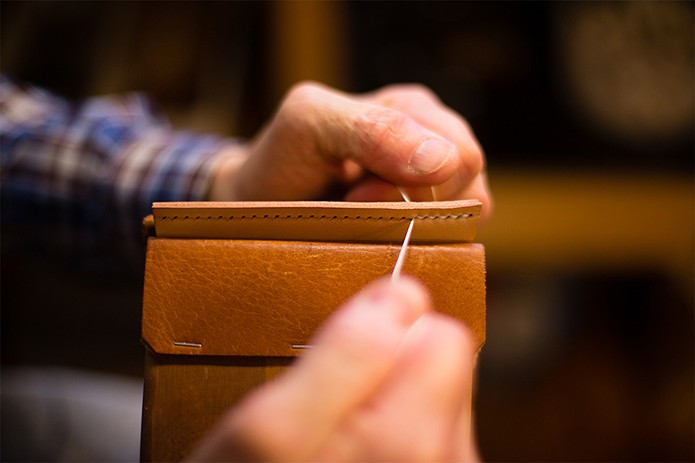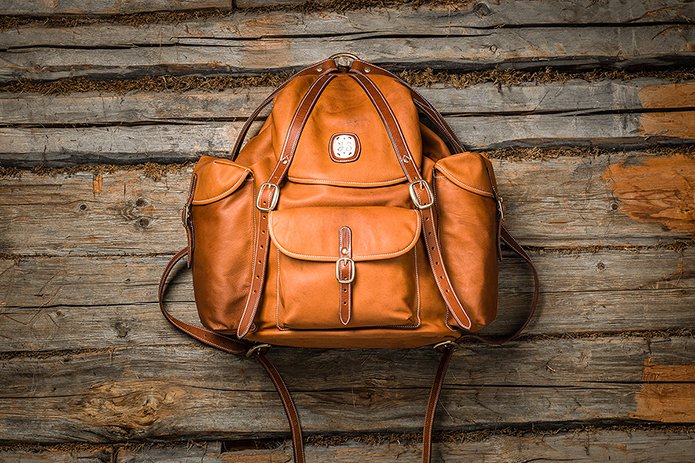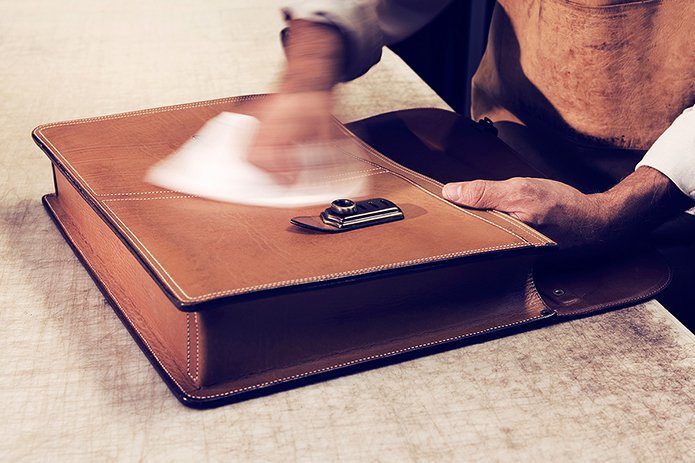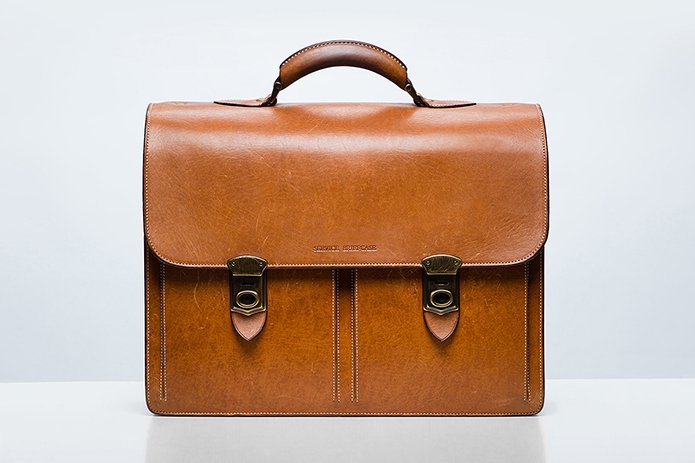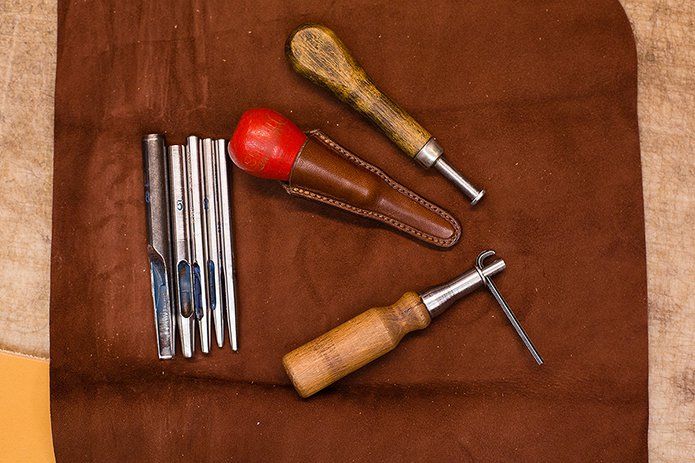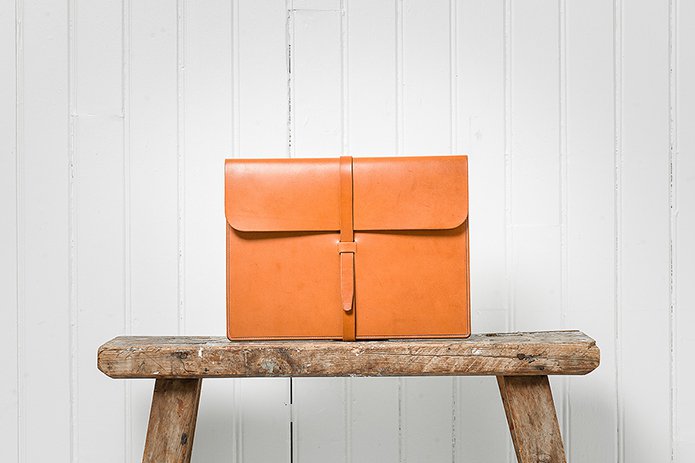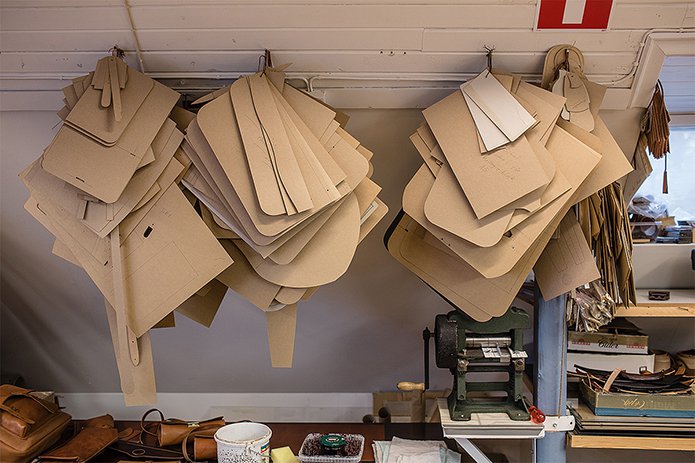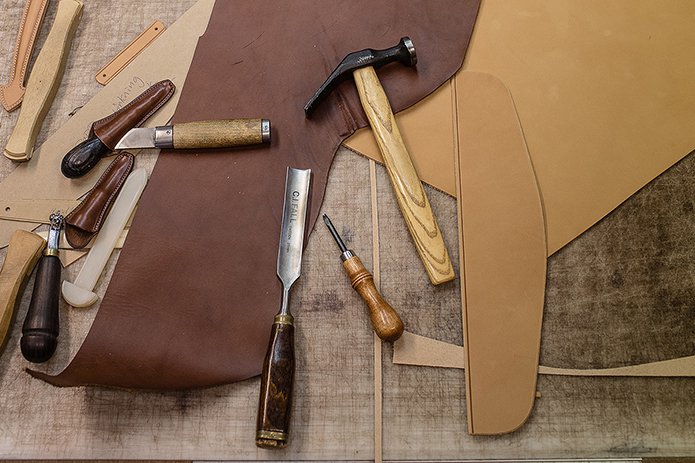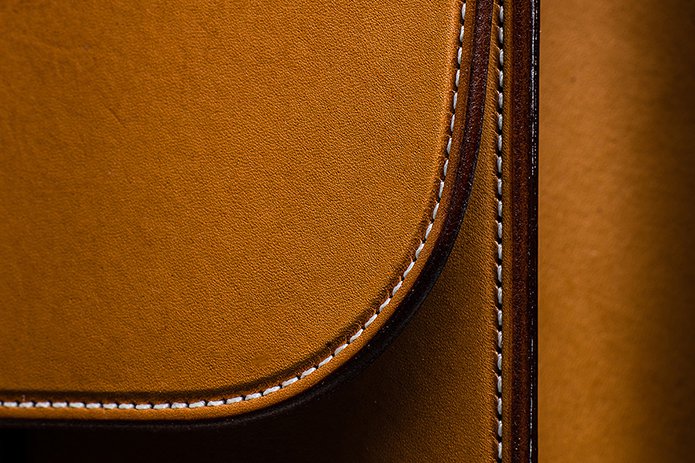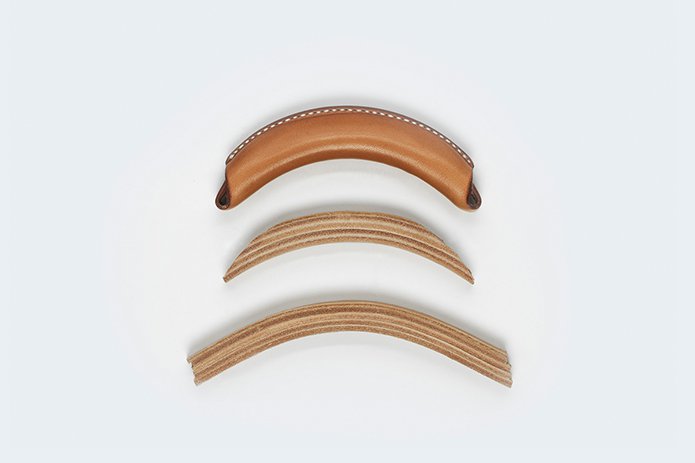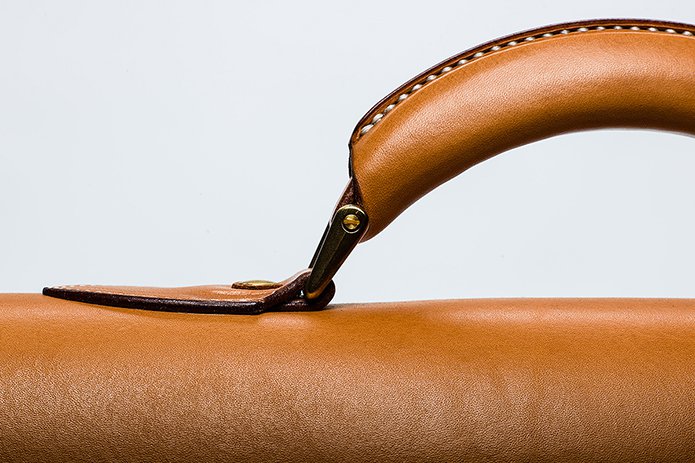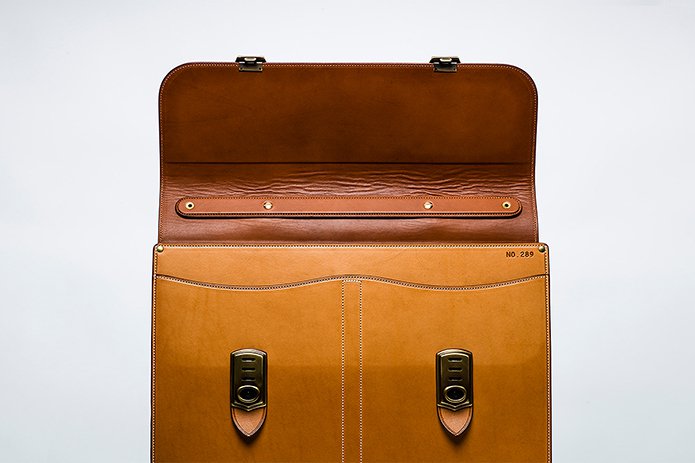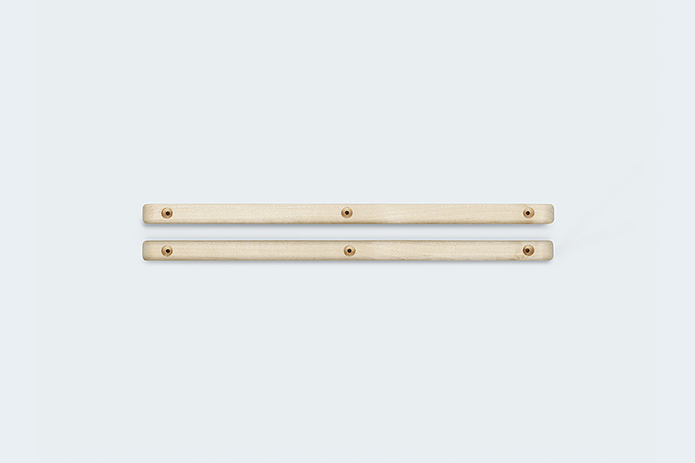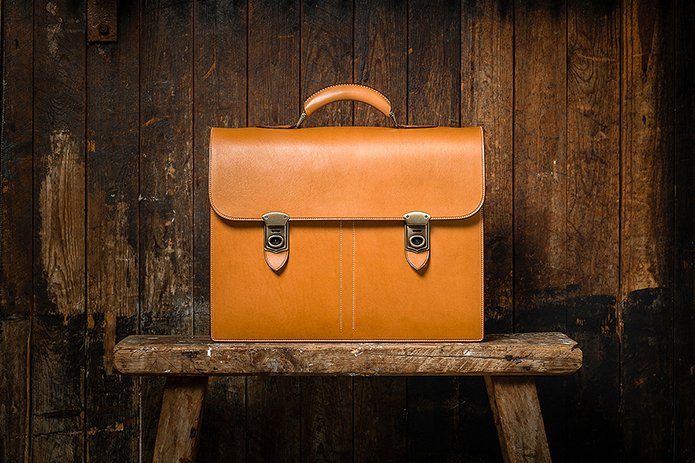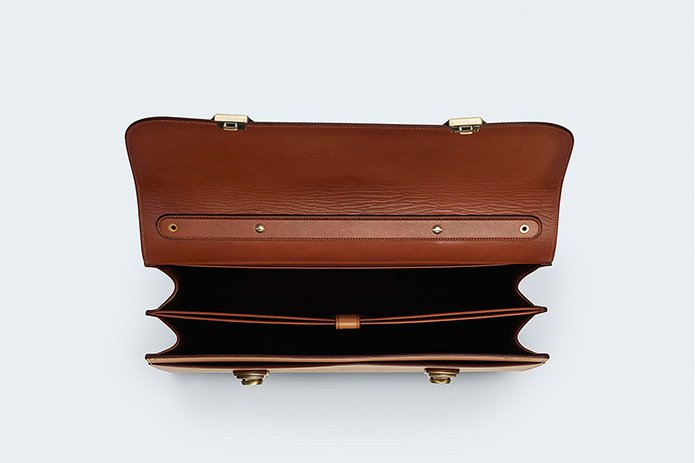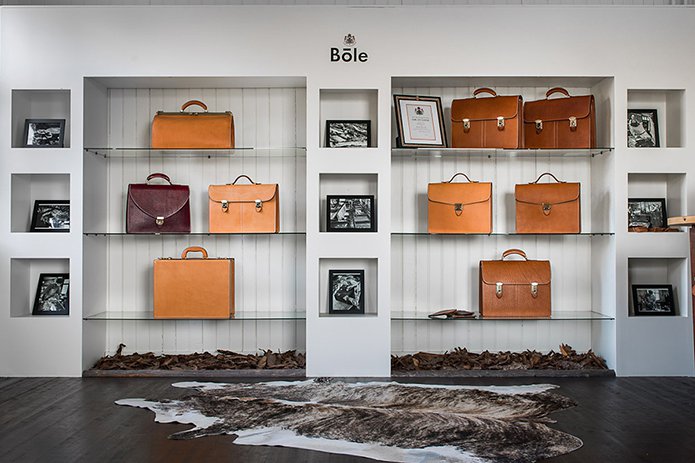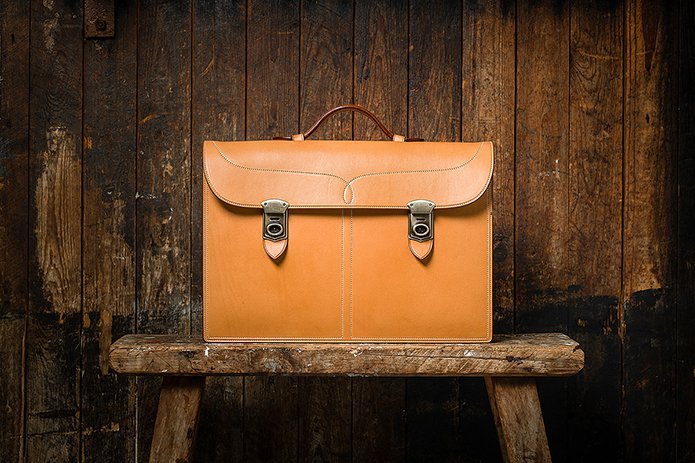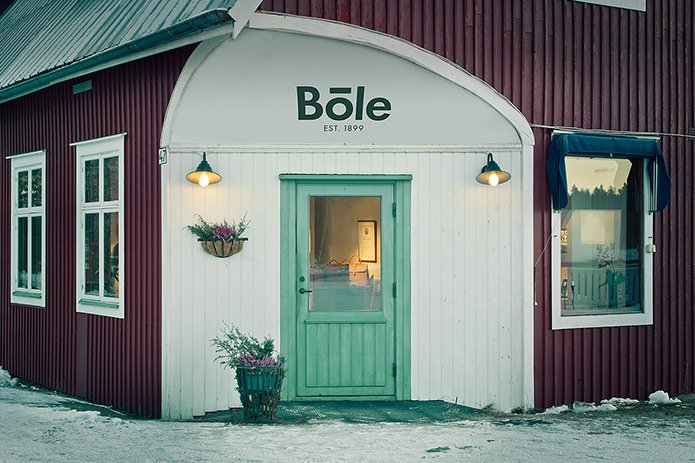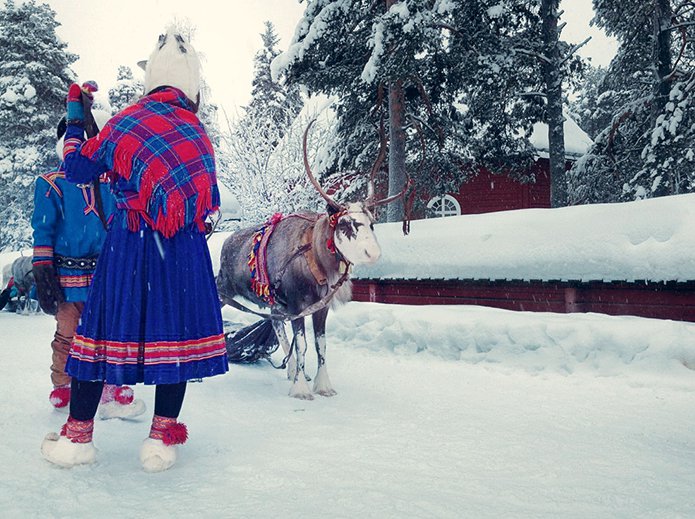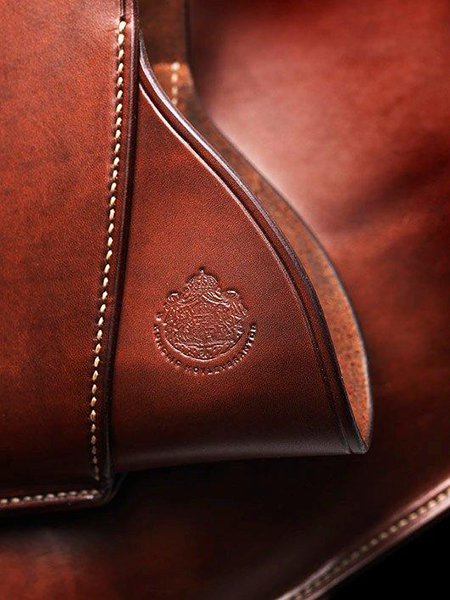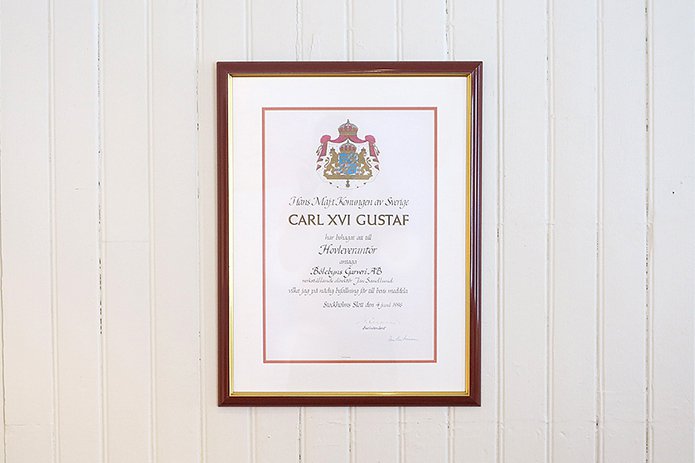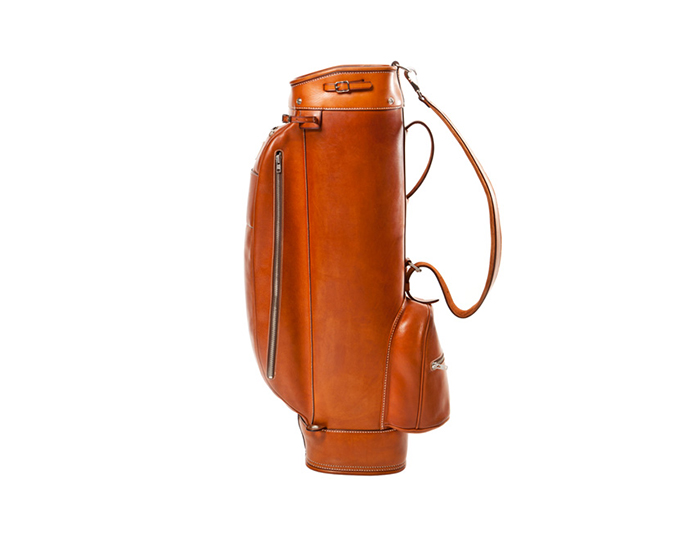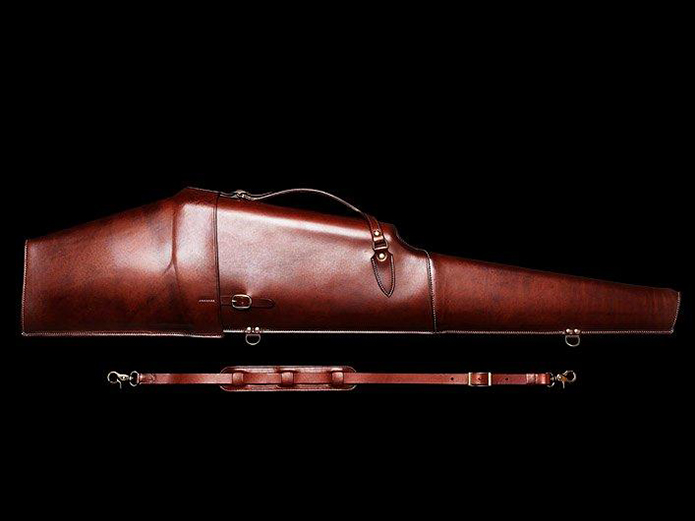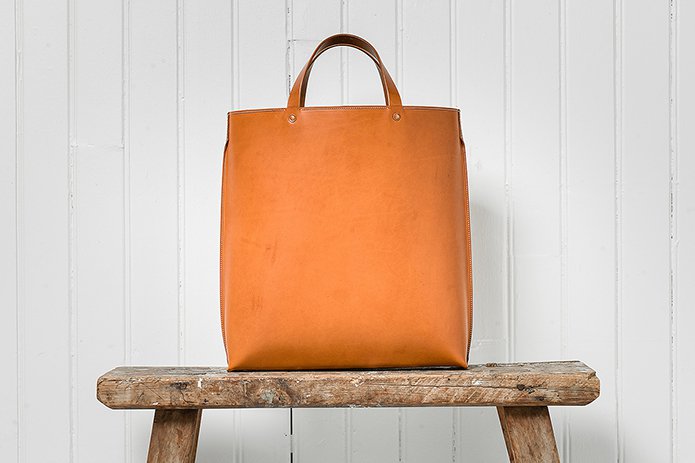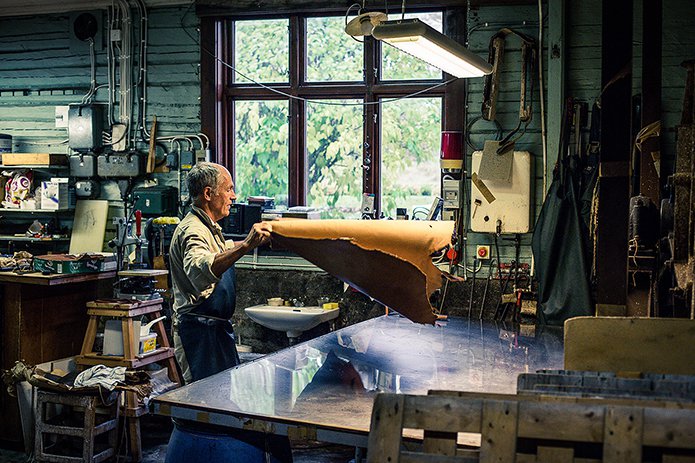
A few months ago we introduced Böle Tannery, the last spruce bark vegetable tannery in the world, located on the banks of the Pite River in Northern Bothnia, Sweden.
In Part One, Anders Sandlund, the fourth generation owner of Böle, gave us a unique insight into the traditional craft of spruce bark tanning, a craft which has remained largely unchanged from when Böle was first established in the late 19th Century.
In Part Two, we have caught up with Jan Sandlund, Master Tanner and third generation owner of Böle, to talk through the saddlery at Böle and how the spruce bark-tanned hides are turned into luxury leather goods and what makes them so special. We hope you enjoy reading this insightful and informative interview…
Firstly, for those readers who aren’t familiar with Böle saddlery, please can you explain what you do?
We make leather goods in our saddlery from vegetable-tanned leather which we produce in our own tannery. Both the tannery and saddlery are based in the same building – the hides are tanned downstairs and when they are ready after one year they are carried upstairs to the saddlery where they are inspected and graded and then handcrafted into a range of leather goods. The leather from the tannery is naturally coloured by the spruce bark tanning agent which gives the leather a warm, pale finish which is completely unique.
We make everything from briefcases, tote bags, laptop cases, rifle bags and backpacks to smaller items such as wallets and belts. Many of our customers ask us to make bespoke items which we regularly do.
Can you define the uniqueness of your leather products and why they are so well-received by customers all around the world?
There are many reasons, but the key ones are simplicity, functionality, durability, beauty and craftsmanship.
Swedish products are renowned for their simple design and functionality. In many ways this is down to our geographic location – living in the cold north, our forefathers had a harsh life, and I certainly remember that was the case for my grandparent’s generation. Our ancestors simply couldn’t afford for things to go wrong. I think that has influenced our thinking, in that when we make something, it has to be functional and be exceptionally well made to last a long time. It’s all well and good having a fancy design that looks beautiful, but we know it will break, so we don’t do it. When we create a new design, the first thing we do is think about how it can be broken, and prepare for that eventuality, and work out how it can be easily repaired if necessary. I guess our simplistic design is a reflection of our heritage.
The natural colour of our leather has a unique beauty about it. It is a very honest leather that we produce, and the way that we tan it gives no sway or allowances as everything is on display – every nick and dent. Because we don’t paint our leather, we have to work with the natural hide and get the best from it. There are only four tanneries in the world that derive their natural colour from bark, and we are the only one using spruce bark, which we believe is the best. The colour you see is a genuine colour. In that sense we are completely unique.
To complement our own leather we source the best accessories we can find, such as English white thread for the distinctive stitching, Italian and English brass locks, German metal closing mechanisms, American copper rivets, and Swedish birch wooden rails for the bottom. They come together beautifully; not beautiful in an elegant Italian way, but rather a more simple beauty.
I think the fact that our products are so extremely well made, in all details, they literally give off the message ‘you must look at me’! In fact, one of our customers was on an aeroplane recently with his new Doctors bag and he got several admiring glances and comments from fellow passengers about the bag as they hadn’t seen anything like it before.
We’ve met with several luxury retailers in recent years, such as Harrods, Purdey, Dunhill and Holland & Holland to show them some of our new items, including our new rifle bag which has solved the problem of encasing big scope sights, and the feedback has been the same – they were literally blown away by the quality of craftsmanship.
Your website includes a tongue-in-cheek quote by your Master Saddler that “anything made after 1890 is crap”. What do you think he means by that?
He’s referring to the deterioration in standards of leather production throughout the Twentieth century. The way craftsmen used to think was that whatever they made shall last, and items were made with the express intention of being passed onto the next generation as a matter of course. It wasn’t just leather products, it applied to all sorts, such as making a sleigh in advance of the northern winter coming – it would have been made for the person’s lifetime and their children. If you’re going to put so much work into making something, why not put that bit more effort in and do it properly. That was their thinking.
It was really after the 1940s and ‘50s that the deterioration in saddlery became especially noticeable, so Billy’s comment is more pertinent from that era. Shortcuts started to get introduced, such as tanneries taking their leather from different sides of hides just to make it easier for the clicker to cut out hundreds of pieces in quick succession. Whilst this is faster, it also makes it difficult to assure the quality of the leather and a product could be made from many different hides, whereas we will always make an item out of the same side to ensure consistency.
The deterioration also applies to the quality of stitching. I’ve seen bags costing Euro 3,000 with uneven stitches around the curves, for instance, instead of even length stitches all the way around. It’s all to do with the needle system and not letting the machine rule the stitches – a real artisan would never allow that. It also raises the question where the craftsman has made shortcuts elsewhere as well…
It’s all down to the mindset. Billy simply won’t accept any shortcuts. It’s the same when he’s asked about a new product and how long it will take to make… He’ll never give a quick answer and will ponder the question for a few days until he has thought through all aspects in detail, for instance, what the impact of adding a magnetic lock or buckle could have on other areas. We’ve learned now to never expect a response from Billy for a few days at the very least…
To see a real craftsmen, like Billy, at work is something else but sadly it’s not commonplace these days. Billy’s father was the same – an ordinary fellow, whose job was to dig ditches, but he could turn his hand to making a wooden boat or exquisite fiddle in his spare time. He was a good handicraft man, and Billy inherited his thinking. I’ve been told by one of his siblings how, when he was seven years old, he made a leather holster for a toy gun – as he was into cowboy things at the time – but threw it away in disgust. When asked why he did that he explained it was because it didn’t come up well, and so set about making a new one – at the age of seven, that’s pretty remarkable.
Comparatively, Böle leather products are more expensive than many other leather goods on the market and any purchase would need to be considered an investment for most. What are people paying the higher price tag for?
Actually, I think they are taking part in a bit of history. I’m sorry to say it, but the quality of products we make, and the attention to detail, this type of thinking and acting is vanishing. If you’d like to have a high quality item made in a very conscientious and good way, then you should buy our product and support our way of thinking.
Our products will last a lifetime because of the quality of materials and their design and construction. A product that will last a lifetime will always cost more than something that is designed to only last a few years, which is really just a false economy, as you will need to buy many of these items over the course of a lifetime, but with ours you won’t. The fact our products last such a long time, character comes out in the leather over time with aging, and many of our customers come to view them as a friend or companion in a way.
Of course, these are not cheap items, and the person must really want one and think clearly about it and qualify in their minds before buying. If it doesn’t feel right, then it’s probably best not to buy. The types of people that have really thought about it are the type of customers we like.
How long can we expect your leather products to last, and what can we do to improve longevity?
If care is taken looking after the product, it will last a lifetime – 50 years or more – and is likely to be passed onto the next generation.
The biggest problem affecting leather is when it becomes wet as it can lose its form. Our advice is to let the leather dry out naturally, which can be helped by pressing crumpled newspaper inside the items to draw the water out, but being careful to protect the inside from ink print. Towels are probably better to absorb the water, and to give the leather back its original shape. If wet anyway, it’s probably a good idea to wash with saddle soap, which will get the leather even more wet, but will improve it afterwards. I would also suggest adding some leather care on the leather, but do it when the leather is still damp as it goes in better. I’d then allow the leather to dry naturally and then polish gently with a soft cloth. To get maximum longevity from the item, it’s a good idea to clean and care for the leather in this way 3 or 4 times per year regardless.
Often people make the mistake of not standing the item upright when drying, which misforms it and causes it to lose its original shape. When this happens it’s probably best to send it back to us and we can restore its original shape again.
If something breaks on the item, I would strongly recommend to fix it immediately. The simplicity of our designs means that the items are constructed in a way that allows them to be easily repairable. We supply spare parts if customers want to make repairs themselves, which they can normally do with a simple screwdriver, otherwise they can send it back to us and we will do it for them. The key is not to wait as the problem will only get worse, for example, a screw that might have been protecting stitching on a handle, for instance, when damaged might affect the stitching around it, and so there can be knock-on repercussions if something is left un-repaired.
Our products come with a 15 year warranty, and our rucksacks and briefcases come with a free annual service for the first fifteen years, so we’re on hand if there’s any problems.
Is there such as thing as a typical Böle customer, and if so, how would you describe them?
I’ve been thinking about this for many years. I don’t think there is a typical customer in terms of their status; we have highly placed customers, a CEO maybe, that can more easily afford an item, as well less wealthy people who have saved up for a long time and are making a once-in-a-lifetime purchase. There is, however, a commonality in terms of attitude of customer – they all reject the notion of a throwaway society and want to invest in special items that will last a very long time and like having nice things around them; they’re the same type of people that will buy a nice Japanese teapot instead of a cheaper alternative. These people like to prioritise their purchases.
By way of an insight into the artisanal nature of your work, could you briefly describe the process of crafting one of your leather products, such as a briefcase, and explain some of the key stages?
After the Swedish cattle leather has been tanned for a year, it is brought up to the saddlery to be inspected and graded. The leather is very naked and it takes a lot of time to check for scratches and marks that would have occurred during the lifetime of the cow roaming fields.
Once a side of leather has been found that is suitable, it is put on a table and a lamp is shone across it for a closer inspection. Templates for the various parts of the briefcase are placed over the leather to ensure it is possible to cut out all the pieces from the same side.
The saddle maker ensures that all the necessary pieces of leather are aligned so that the fibres run in the same direction. This is important as it will determine how different forces will pull together if the briefcase is loaded with a heavy weight.
The leather is then cut by hand. There is a lot of wastage, as much as 50% is spilled leather, which means it can’t be used in the making of the briefcase. Some of this leather can, however, be used to make smaller items in our Classic line.
In addition to cutting out Swedish cattle leather for the exterior of the briefcase, we also go through the same process for cutting out pieces of reindeer skin which will be used for the inside lining of the briefcase and the underside of the front panel. The reindeer skin is cut out as slightly over-sized pieces. Only after they have been glued to the Swedish cattle leather, and hammered, is the surplus lining cut away so the two edges become one.
The single most time consuming aspect of making a brief briefcase is treating the edges, which is done in different stages. Whilst many leather manufacturers thin their leather to wrap around the edges, we like to keep both the Swedish cattle leather and reindeer skin visible. However, to ensure the edges are protected from the elements, we treat the edges using a process involving polishing and colouring. The edge is bevelled, cut and grooved, followed by 6 strokes of water-based colouring applied using felt made from 100% sheep wool. The edges are then polished, and then the colouring and polishing process is repeated once again, or as many times as necessary, to achieve the right colour. The dark brown edging colour contrasts nicely with the natural colour of the spruce bark tanned leather.
The handles are made out of a separate piece of Swedish cattle leather. Several layers of 3mm thick leather are cut to shape and glued together. For a nice profile, the cord is wetted and folded to create a curved back.
Once set, the leather handle will not bend or break, unlike plastic or metal alternatives, and it is very light. This leather handle insert is placed inside a sleeve of grain leather.
Prior to stitching, all parts of the leather are washed with saddle soap and left to dry. The various parts are stitched together. Our master saddler always does the handle and lock parts first as he thinks these are the most interesting parts. A metal rod inserted in the lid is dressed with leather.
Bottom rails are mounted on the base which are also dressed with leather. Birch wood is used as it is light and gently changes colour with age along with the leather.
The final stage is oiling the briefcase, to give its nice leather finish. One thing to remember though – don’t take the briefcase away too early from its maker! The saddler will want to keep it for a while, to look at it, and see how it came out after all the planning – it really does have a significance for them.
In total, it takes about a week to make the briefcase, but this doesn’t allow for time spent gluing, washing and resting the leather for the various stages, as well as the year it took us to tan the leather originally. I remember talking to an elderly gentleman whilst on holiday in Italy about 20 years ago, who knew a lot about the Italian leather trade, and he couldn’t believe we were still making leather goods the way we were, and still are of course. We want to ensure Böle leather goods are always made in this special way.
With the hides that come from your tannery, what kind of consistency can you expect?
All hides vary in colour, to a greater or lesser degree; just the same as people have different skin tones. Some hides are more blonde in colour, and others darker. The spruce bark imparts a distinctive warm colour to the leather after tanning, which becomes lighter with drying, but there are still differences in tone. If we want a particular hide to become darker, we can sun tan the leather by leaving it in sunlight, just the same as our arms go darker in the sun. Alternatively we can use a special oil to get the same effect.
We tell our customers that when they buy a briefcase, for instance, the inside and underlid will be lighter than the outside of the briefcase, and that’s because the sun hasn’t got to it. If the customer doesn’t want this to stand out, we advise to leave the lid open in a room with indirect sunlight whilst they go on holiday for a fortnight and by the time they come back the leather will have darkened to match the outside of the briefcase. Sometimes we’ll darken these parts of the briefcase beforehand, so they’ll appear darker initially compared to the exterior, but over time, the exterior will darken the same.
Natural coloured un-dyed leather is what we do at here at Böle as that’s the best there is, but if a customer wants a specific colour we can hand dye the leather to another living colour, such as ox blood, black or antique brown. This isn’t a quick process, as it’s all done by hand by applying the dye in small circular movements, rather than straight strokes, several times until the surface is saturated. It’s actually quite nice to see the gradual shifts in colour, and the surface looks a bit ‘alive’.
As well as inconsistency in colours from one hide to the next, there is also inconsistency in the quality of leather on an individual hide. When the hide is laid out – one hide has two sides – the saddler has to be careful which part of the hide to use. If we take our briefcases as an example, one side is used to make one briefcase. Within that side, the saddler cannot select leather from more than 60 cm away from the spine edge, as the belly is too loose fibred, and if the briefcase was made from belly leather, the lower panels will be soft and will sink down, which we don’t want. Likewise we can’t use leather too close to the neck end, as there are more wrinkles there and, again, the leather is too loose fibred. In total, we can only use approximately 190 cm length of the side, and 60 cm width to make a briefcase, and the remainder is spare leather that can be used for other smaller items which don’t need to be so stiff.
Is it possible to visit the Böle workshop?
Absolutely, we get a lot of visitors here, and we give guided tours. We’ve featured on the television quite a lot over the years, and back in 1981 a 35 minute programme went out a peak time about how we made beak boots, the traditional footwear of the indigenous Sami people; as there were only two TV channels at the time, we had an audience of millions! I think the television coverage we have received has actually helped a lot in this respect, and we’re actually one of the main attractions in this part of Sweden.
The King of Sweden even visited us in 1999 and we presented him with a really precious rifle slip. Visitors can travel by public transport from Luleå airport 50 km away, or they can land their own plane on a nearby former military airstrip, and we will pick them up by car, snow scooter or even by sleigh in the winter months.
Böle has been appointed as a royal purveyor to the King Of Sweden; can you explain what it means to you?
It’s a very special honour to hold a Royal Warrant and is a sign of quality in Sweden, as well as in other countries too. The Royal Warrant is awarded by the King of Sweden, and there only 138 royal purveyors in total, so it is very special to us. We get to use the Royal Crest in the marketing of our products, but we do this sparingly. Ultimately want to get the balance right and want to be able to stand by ourselves, and not seen as reliant on the royal connection, so we don’t emblazon the crest all over our products, but just on a few pieces.
To be eligible for the Royal Warrant, you have to apply to become one, but only after delivering goods to the Royal Court for a number of years. We supplied many hundreds of picture frames – wooden frames dressed with leather – to the King and Queen of Sweden which were gifted to ambassadors and heads of state, which meant we qualified on that basis, but other factors are taken into consideration, such as the good reputation, morals and ethics of the company. We have a diploma acknowledging our award, which hangs proudly in our workshop.
In addition to your standard products, you also make bespoke items; can you give an insight into what sort of items you would consider, and how a customer would go about making a bespoke order?
Provided it’s made from leather, we can make pretty much anything that a customer can ask for, although we don’t make clothes or shoes, but everything else, such as briefcases, backpacks, portfolios, golf bags, hunting rifle slips, watch straps, camera cases, hat boxes, plus many more things for everyday life. There are some things we can’t do with machine stitching, but with hand-stitching we can do anything.
If a customer wants a bespoke piece made, they need to contact us directly and tell us what they want, in detail, and provide us with dimensions and pictures of the type of thing they are looking for. From that, we’ll go away, look at the request in detail determining the materials and construction required, and come back with a range that we estimate the price will be. It’s difficult to know all the details at the outset, so we’ll quote a range which the customer won’t pay any more or less than what has been quoted. If the customer approves, we’ll proceed.
We completed a bespoke portfolio for a customer in Holland recently who wanted a leather portfolio design to fit his laptop exactly. He gave us the measurements, so we carved a last out of a block of wood, and created a portfolio that matched his laptop exactly. He was very happy. Another customer who had been hunting in South Africa wanted some items to be made from the hide of a buffalo he shot, such as aprons and belts. He wanted one of the aprons to emphasise the bullet hole in the leather, which was a heart shot. We ended up tanning the hide so we could have full control over the quality of the leather, and created an apron which showed off the bullet hole in the pocket of the apron with intricate stitching around the hole to emphasise the shot.
We always take photographs so the customer has a nice keepsake of how the item was made, and sometimes, when we’re half way through the project and there are choices to be decided, we’ll send the customer images to show the various options available for them at that particular stage to choose from.
Whilst we can do most things, there are some times when we draw the line if we think it won’t work properly and is likely to break in the future. Then we just have to politely decline.
Finally, what’s next for Böle in terms of developing new products?
I anticipate we’ll continue to develop our range of smaller items, such as tote bags, toiletry bags, underarm portfolios, weekend bags etc. In fact, we have in mind a very special weekend bag in development which will be impossible to break due to it being made in a special way. We need a special sewing machine to achieve this, which we’re sourcing at the moment. There’s lots of scope for us to develop our small items, such as different kinds of travel purses, wallets and belts, which will be in a price range that will be more acceptable for a larger number of people.
Thanks to Jan Sandlund for taking time out of his busy schedule to answer our questions. All images courtesy of Böle.

